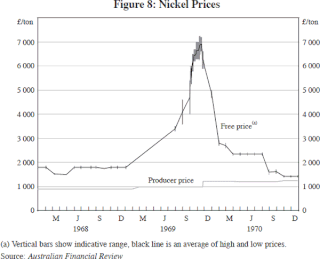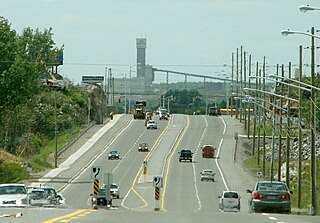
Vale Canada Limited is a wholly owned subsidiary of the Brazilian mining company Vale. Vale's nickel mining and metals division is headquartered in Toronto, Ontario, Canada. It produces nickel, copper, cobalt, platinum, rhodium, ruthenium, iridium, gold, and silver. Prior to being purchased by CVRD in 2006, Inco was the world's second largest producer of nickel, and the third largest mining company outside South Africa and Russia of platinum group metals. It was also a charter member of the 30-stock Dow Jones Industrial Average formed on October 1, 1928.

Walden was a town in the Canadian province of Ontario, which existed from 1973 to 2000. Created as part of the Regional Municipality of Sudbury when regional government was introduced, the town was dissolved when the city of Greater Sudbury was incorporated on January 1, 2001. The name Walden continues to be informally used to designate the area.

Thompson is a city in north-central Manitoba, Canada, the largest city and most populated municipality in Northern Manitoba.
Falconbridge Nickel Mines Limited was a Canadian mining company with operations in 18 countries, involved in the exploration, mining, processing, and marketing of metal and mineral products, including nickel, copper, cobalt, and platinum. In 1982 the company was renamed Falconbridge Limited. It was listed on the TSX and NYSE (FAL), and had revenue of US$6.9 billion in 2005. In August 2006, it was absorbed by Swiss-based mining company Xstrata, which had formerly been a major shareholder. On 28 October 2007, Falconbridge Limited changed its name to the Xstrata Canada Corporation.

The Poseidon bubble was a stock market bubble in which the price of Australian mining shares soared in late 1969, then crashed in early 1970. It was triggered by the discovery by Poseidon NL of the early indications of a promising nickel deposit in September 1969.

Vale, formerly Companhia Vale do Rio Doce, is a Brazilian multinational corporation engaged in metals and mining and one of the largest logistics operators in Brazil. Vale is the largest producer of iron ore and nickel in the world. It also produces manganese, ferroalloys, copper, bauxite, potash, kaolin, and cobalt; as of 2014 the company operated nine hydroelectricity plants, and a large network of railroads, ships, and ports used to transport its products.
The Gawler Craton covers approximately 440,000 square kilometres of central South Australia. Its Precambrian crystalline basement crustal block was cratonised ca. 1550–1450 Ma. Prior to 1550 Ma the craton comprised a number of active Proterozoic orogenic belts extending back in time to at least 2450 Ma.
Raglan Mine is a large nickel mining complex in the Nunavik region of northern Quebec, Canada. It is located approximately 100 kilometres (62 mi) south of Deception Bay. Discovery of the deposits is credited to Murray Edmund Watts in 1931 or 1932. It is owned and operated by Glencore Canada Corporation. The mine site is located in sub-arctic permafrost of the Cape Smith Belt, with an average underground temperature of −15 °C (5 °F).

Kidd Mine or Kidd Creek Mine is an underground base metal (copper-zinc-silver) mine 24 km (15 mi) north of Timmins, Ontario, Canada. It is owned and operated by Swiss multinational Glencore Inc. The ore deposit was discovered in 1959 by Texas Gulf Sulfur Company. Exploration drilling at the Kidd site began in November 1963. In 1981, it was sold to Canada Development Corporation, then sold in 1986 to Falconbridge Ltd., which in 2006 was acquired by Xstrata, which in turn merged with Glencore in 2013. Ore from the Kidd Mine is processed into concentrate at the Kidd Metallurgical Site, located 27 km (17 mi) southeast of the mine, which until 2010 also smelted the ore and refined the metal produced. Following the closure of most of the Met Site, concentrate is now shipped to Quebec for processing. Kidd Mine is the world's deepest copper-zinc mine.
Garson Mine is an underground nickel mine located in the community of Garson, within the city of Greater Sudbury, Ontario, Canada. Part of the Sudbury Basin, the Garson mine was developed around 1908 by Mond Nickel Company, and is now owned by Vale Inco.

Voisey's Bay Mine is a nickel mine in Labrador, Canada, near the bay of the same name. The mine is located about 35 km (22 mi) southwest of Nain.
Bob Desjarlais was a prominent labour leader in Thompson, Manitoba, Canada, having served as president of the United Steelworkers of America Local 6166 in the 1990s.

Creighton Mine is an underground nickel, copper, and platinum-group elements (PGE) mine. It is presently owned and operated by Vale Limited in the city of Greater Sudbury, Ontario, Canada. Open pit mining began in 1901, and underground mining began in 1906. The mine is situated in the Sudbury Igneous Complex (SIC) in its South Range geologic unit. The mine is the source of many excavation-related seismic events, such as earthquakes and rock burst events. It is home to SNOLAB, and is currently the deepest nickel mine in Canada. Expansion projects to deepen the Creighton Mine are currently underway.

Frood-Stobie Mine is a nickel mine in Greater Sudbury, Ontario, named for Thomas Frood, an employee of the federal department of Crown lands who prospected and staked many of the early mining claims in the area. A major arterial road in the city is also named for Frood.

The Mond Nickel Company Limited was a United Kingdom-based mining company, formed on September 20, 1900, licensed in Canada to carry on business in the province of Ontario, from October 16, 1900. The firm was founded by Ludwig Mond (1839–1909) to process Canadian ore from mines near Sudbury, which were then shipped to Mond's works in Britain for final purification via his patented carbonyl process.

The Circum-Superior Belt is a widespread Paleoproterozoic large igneous province in the Canadian Shield of Northern, Western and Eastern Canada. It extends more than 3,400 km (2,100 mi) from northeastern Manitoba through northwestern Ontario, southern Nunavut to northern Quebec and into western Labrador. Igneous rocks of the Circum-Superior Belt are mafic-ultramafic in composition, deposited in the Labrador Trough near Ungava Bay, the Cape Smith Belt near the southern shore of Hudson Strait and along the eastern shore of Hudson Bay in its northern portion; the Thompson and Fox River belts in the northwest and the Marquette Range Supergroup in its southern portion. The Circum Superior Belt also hosts a rare example of Proterozoic Komatiite, in the Winnipegosis komatiite belt.

The Goro mine is a large nickel mine in the south of New Caledonia, near the township of Yaté, Prony Bay, in the South Province. It was owned by the Brazilian company Vale, who, after failing to sell it to Melbourne-based New Century Mining in June 2020 sold it to Prony Resources New Caledonia consortium in April 2021. The large mine and plant was opened at Goro in 2010 although it has had frequent problems and stoppages.
The Sorowako mine is a large open pit lateritic nickel mine in the east of Indonesia in the Verbeek Mountains of Sulawesi. It lies just south of Lake Matano. As of 2023, Sorowako is one of the largest nickel mines in the world with proven and probable nickel reserves of 107 million tonnes of ore grading 1.70% nickel, containing 1.81 million tonnes of nickel metal.
Gordon Lake Mine was an underground copper mine near Werner Lake in the Kenora District of Ontario Canada.
Samuel J. Ritchie, an American millionaire from Ohio, founded the Canadian Copper Company (CCC) in 1886 to exploit the minerals near what was to become known after 1902 as Copper Cliff. He was also president of the Central Ontario Railroad (COR).











